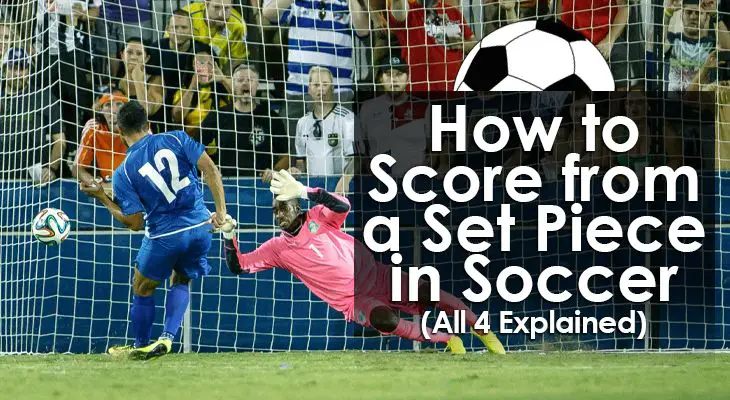How to Score from a Set Piece in Soccer (All 4 Explained)
A set piece is one of many ways a team gets an advantage to create a chance for a goal.
It's also sometimes referred to as a “set-play” or a “dead ball”.
As is the case with open play goals, set pieces goal can be a result of great teamwork, a mistake from the opponent, a training ground move, or individual brilliance.
To take full advantage of set pieces, a team requires a skilled player in that area.
It gives the team an extra advantage, particularly when struggling to break the opponent down through open play.
This article reviews the different types of set pieces, and how a team can take advantage of each one to score.
What Are The Types of Set Pieces?
There are four types of set pieces:
- Throw-ins
- Corner Kicks
- Free Kicks
- Penalties
Each one of these set pieces is typically executed differently, and there are various ways by which a team can take advantage of them to score a goal.
Let’s have a look at some options!

1. Throw-Ins
This is the only set piece where the team in possession of the ball is not allowed to score directly.
If the thrower throws the ball into the opponent’s goal, a goal-kick is awarded, and if they throw it into their own goal, a corner kick is awarded.
This means that throw-ins require more teamwork than the other set pieces.
If the throw-in occurs from a point of the field close to the opponent’s 18-yard area, then there’s a much higher chance of it resulting in a goal.
This would require a long throw from the thrower.
Teams should assign someone with a long arm reach and enough power to generate speed on the ball they throw. (here's my guide for powerful and accurate throw-ins)
A popular example of one of the best ball throwers that soccer has seen is Rory Delap.
Delap was famous for his long throws, causing confusion in the box and allowing his teammates to take advantage and score.
Along with a good ball thrower (use these drills to practice), your team needs to have tall players in the opponent’s area to win the header from the throw.
This will give the team a higher chance of scoring from the header or winning the second ball resulting from it and then scoring from that.
Goals from throw-ins are rare, but when they do happen, this is the most effective way.
2. Corner Kicks
Scoring directly from a corner kick is possible, although very rare.
A goal scored directly from a corner kick is called an “Olympico”.
To score an Olympico, a number of things should ideally be in place:
- Defenders should not be on the goal line, otherwise, it would be fairly easy for them to clear the attempt.
- The goalkeeper should be off the goal line, otherwise, it could be hard to lob them from that distance.
- The kicker must be able to get the exact right amount of bend on the ball, otherwise, it would go out of play or into the arms of the keeper.
But an Olympico is not the only way to score from a corner kick.
Just as is the case with throw-ins, a bit of teamwork or a well-rehearsed training ground move can be just as effective.
If the attacking team has aerially dominant players in the opposition area, then the kicker should do their best to target those players for a header on target.
Winning the second ball can also be very useful here also.
There are a number of different types of indirect corner-kicks.
Choosing the best one for the situation can often be the difference-maker between a poor attempt and one that leads to a goal.
The various types include:
- Short corner
- Near-post corner
- Far post corner
- Inswinging corner
- Mid-range corner
- Outswinging corner
3. Free Kicks
For an indirect free kick, the taker must involve another player to try and score, as a goal from an indirect free kick is not allowed.
If you’re in a position to whip the ball into the box from an indirect free-kick, it's best to try to find a teammate that is strong in the air.
Alternatively, it’s not a bad idea to practice a move on the training ground that you can replicate in a real game situation.
If your position is still far from the opponent’s area, it may be beneficial to consider playing a quick free-kick, especially if the opponent’s defensive players are yet to recover to their positions.
This can set up a nice counterattack where your team can overload the opponent with numbers and score.
Scoring from a Direct Free Kick
A direct free-kick is one of the set pieces players can score from.
Here are a few tips to score in these situations:
#1
When you place the ball on the ground, look up and decide where you want to hit it to.
#2
If the goalkeeper’s position is skewed towards one side of the goalpost, aim for the other side so the ball is hard to reach.
#3
Work on placement and power in training. You need to have enough placement to hit the ball far from the reach of the goalkeeper, but you also need enough power to make it too fast to catch or punch.
#4
A “knuckleball” attempt can help with getting the ball over the wall with some swerve. You can attempt this by striking the center of the ball, connecting with the bottom, and driving up through it.
#5
Follow through the motion of your kick to guide the ball in the proper direction.
Juninho is one of the best free-kick takers of all time.
He scored 77 free kicks in his career, so you can learn a lot from his technique.
4. Penalties
Penalties are the easiest to score from, as there's a significantly higher occurrence of penalty goals than misses.
More often than not, even an average-quality penalty kick will end up in the back of the net because the goalkeeper guessed incorrectly.
To be great at scoring penalties, it's important to find a technique that works well for you and then put in a lot of practice towards perfecting that technique.
It will be useful to watch various techniques from different players to help you decide on an approach here.
It's also important to keep a clear head at all times and try to stay composed regardless of the antics of the keeper or pressure from opponents.
Conclusion
For any team, having set piece specialists is a huge advantage.
In fact, some teams set up their tactics in some games to stifle the opposition’s attack, limiting their own attacking efforts to set-piece opportunities.
The beauty of set-pieces also includes the fact that it gives a very good opportunity to score completely against the run of play.
Even if the opponent has completely dominated the game and not allowed any chances from open play, any set-piece opportunity from a good position can be a very good chance.
With the right training, and having the right personnel on the field to maximize these opportunities, set-pieces should be a crucial part of the tactical setup for any soccer club.

